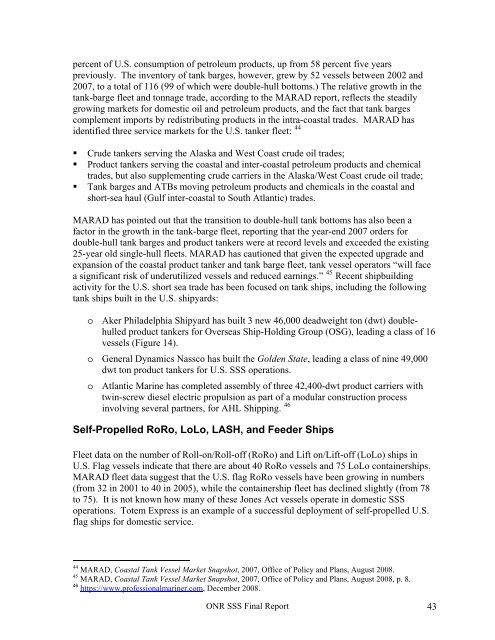Office of Naval Research - National Transportation Library
Office of Naval Research - National Transportation Library
Office of Naval Research - National Transportation Library
You also want an ePaper? Increase the reach of your titles
YUMPU automatically turns print PDFs into web optimized ePapers that Google loves.
percent <strong>of</strong> U.S. consumption <strong>of</strong> petroleum products, up from 58 percent five yearspreviously. The inventory <strong>of</strong> tank barges, however, grew by 52 vessels between 2002 and2007, to a total <strong>of</strong> 116 (99 <strong>of</strong> which were double-hull bottoms.) The relative growth in thetank-barge fleet and tonnage trade, according to the MARAD report, reflects the steadilygrowing markets for domestic oil and petroleum products, and the fact that tank bargescomplement imports by redistributing products in the intra-coastal trades. MARAD hasidentified three service markets for the U.S. tanker fleet: 44• Crude tankers serving the Alaska and West Coast crude oil trades;• Product tankers serving the coastal and inter-coastal petroleum products and chemicaltrades, but also supplementing crude carriers in the Alaska/West Coast crude oil trade;• Tank barges and ATBs moving petroleum products and chemicals in the coastal andshort-sea haul (Gulf inter-coastal to South Atlantic) trades.MARAD has pointed out that the transition to double-hull tank bottoms has also been afactor in the growth in the tank-barge fleet, reporting that the year-end 2007 orders fordouble-hull tank barges and product tankers were at record levels and exceeded the existing25-year old single-hull fleets. MARAD has cautioned that given the expected upgrade andexpansion <strong>of</strong> the coastal product tanker and tank barge fleet, tank vessel operators “will facea significant risk <strong>of</strong> underutilized vessels and reduced earnings.” 45 Recent shipbuildingactivity for the U.S. short sea trade has been focused on tank ships, including the followingtank ships built in the U.S. shipyards:o Aker Philadelphia Shipyard has built 3 new 46,000 deadweight ton (dwt) doublehulledproduct tankers for Overseas Ship-Holding Group (OSG), leading a class <strong>of</strong> 16vessels (Figure 14).o General Dynamics Nassco has built the Golden State, leading a class <strong>of</strong> nine 49,000dwt ton product tankers for U.S. SSS operations.o Atlantic Marine has completed assembly <strong>of</strong> three 42,400-dwt product carriers withtwin-screw diesel electric propulsion as part <strong>of</strong> a modular construction processinvolving several partners, for AHL Shipping. 46Self-Propelled RoRo, LoLo, LASH, and Feeder ShipsFleet data on the number <strong>of</strong> Roll-on/Roll-<strong>of</strong>f (RoRo) and Lift on/Lift-<strong>of</strong>f (LoLo) ships inU.S. Flag vessels indicate that there are about 40 RoRo vessels and 75 LoLo containerships.MARAD fleet data suggest that the U.S. flag RoRo vessels have been growing in numbers(from 32 in 2001 to 40 in 2005), while the containership fleet has declined slightly (from 78to 75). It is not known how many <strong>of</strong> these Jones Act vessels operate in domestic SSSoperations. Totem Express is an example <strong>of</strong> a successful deployment <strong>of</strong> self-propelled U.S.flag ships for domestic service.44 MARAD, Coastal Tank Vessel Market Snapshot, 2007, <strong>Office</strong> <strong>of</strong> Policy and Plans, August 2008.45 MARAD, Coastal Tank Vessel Market Snapshot, 2007, <strong>Office</strong> <strong>of</strong> Policy and Plans, August 2008, p. 8.46 https://www.pr<strong>of</strong>essionalmariner.com, December 2008.ONR SSS Final Report 43
















